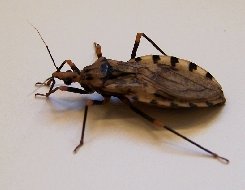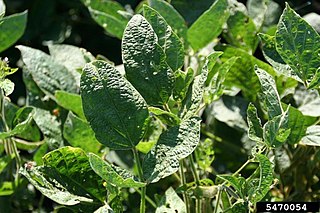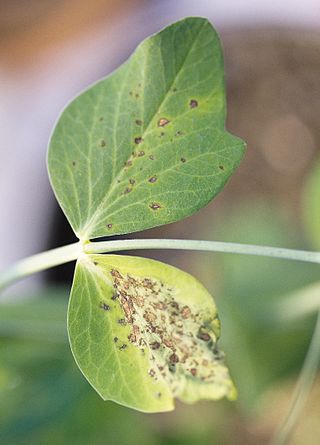
Arbovirus is an informal name for any virus that is transmitted by arthropod vectors. The term arbovirus is a portmanteau word. Tibovirus is sometimes used to more specifically describe viruses transmitted by ticks, a superorder within the arthropods. Arboviruses can affect both animals and plants. In humans, symptoms of arbovirus infection generally occur 3–15 days after exposure to the virus and last three or four days. The most common clinical features of infection are fever, headache, and malaise, but encephalitis and viral hemorrhagic fever may also occur.
In medicine, public health, and biology, transmission is the passing of a pathogen causing communicable disease from an infected host individual or group to a particular individual or group, regardless of whether the other individual was previously infected. The term strictly refers to the transmission of microorganisms directly from one individual to another by one or more of the following means:
Tick-borne diseases, which afflict humans and other animals, are caused by infectious agents transmitted by tick bites. They are caused by infection with a variety of pathogens, including rickettsia and other types of bacteria, viruses, and protozoa. The economic impact of tick-borne diseases is considered to be substantial in humans, and tick-borne diseases are estimated to affect ~80 % of cattle worldwide. Most of these pathogens require passage through vertebrate hosts as part of their life cycle. Tick-borne infections in humans, farm animals, and companion animals are primarily associated with wildlife animal reservoirs. many tick-borne infections in humans involve a complex cycle between wildlife animal reservoirs and tick vectors. The survival and transmission of these tick-borne viruses are closely linked to their interactions with tick vectors and host cells. These viruses are classified into different families, including Asfarviridae, Reoviridae, Rhabdoviridae, Orthomyxoviridae, Bunyaviridae, and Flaviviridae.

Bartonella is a genus of Gram-negative bacteria. It is the only genus in the family Bartonellaceae. Facultative intracellular parasites, Bartonella species can infect healthy people, but are considered especially important as opportunistic pathogens. Bartonella species are transmitted by vectors such as ticks, fleas, sand flies, and mosquitoes. At least eight Bartonella species or subspecies are known to infect humans.

The members of the Triatominae, a subfamily of the Reduviidae, are also known as conenose bugs, kissing bugs, or vampire bugs. Other local names for them used in the Americas include barbeiros, vinchucas, pitos, chipos and chinches. Most of the 130 or more species of this subfamily feed on vertebrate blood; a very small portion of species feed on invertebrates. They are mainly found and widespread in the Americas, with a few species present in Asia and Africa. These bugs usually share shelter with nesting vertebrates, from which they suck blood. In areas where Chagas disease occurs, all triatomine species are potential vectors of the Chagas disease parasite Trypanosoma cruzi, but only those species that are well adapted to living with humans are considered important vectors. Also, proteins released from their bites have been known to induce anaphylaxis in sensitive and sensitized individuals.
White spot syndrome (WSS) is a viral infection of penaeid shrimp. The disease is highly lethal and contagious, killing shrimp quickly. Outbreaks of this disease have wiped out the entire populations of many shrimp farms within a few days, in places throughout the world.

Echinostoma is a genus of trematodes (flukes), which can infect both humans and other animals. These intestinal flukes have a three-host life cycle with snails or other aquatic organisms as intermediate hosts, and a variety of animals, including humans, as their definitive hosts.

Lettuce mosaic virus (LMV) is a typical potyvirus, which causes one of the major virus diseases of lettuce crops worldwide.

Verticillium wilt is a wilt disease affecting over 350 species of eudicot plants. It is caused by six species of Verticillium fungi: V. dahliae, V. albo-atrum, V. longisporum, V. nubilum, V. theobromae and V. tricorpus. Many economically important plants are susceptible including cotton, tomatoes, potatoes, oilseed rape, eggplants, peppers and ornamentals, as well as others in natural vegetation communities. Many eudicot species and cultivars are resistant to the disease and all monocots, gymnosperms and ferns are immune.
Mycosphaerella cruenta, also called Pseudocercosopora cruenta in its asexual stage, is a fungal plant pathogen belonging to the group Ascomycota. It can affect several legume plants, including species of Phaseolus, Vigna, Calopogonium, Lablab niger, Mucuna and Stizolobium deeringianum [Mucuna pruriens][2]. It causes cowpea cercospora leaf spot, one of the most widespread and significant plant diseases in Africa and Asia. A city in China reported a 100% Mycosphaerella cruenta infection rate on cowpea in 2014[5]. In Africa, an epidemic can cause a yield loss of up to 40% [3].

Ascochyta pisi is a fungal plant pathogen that causes ascochyta blight on pea, causing lesions of stems, leaves, and pods. These same symptoms can also be caused by Ascochyta pinodes, and the two fungi are not easily distinguishable.
Alternaria helianthi is a fungal plant pathogen causing a disease in sunflowers known as Alternaria blight of sunflower.

Prunus necrotic ringspot virus (PNRSV) is a plant pathogenic virus causing ring spot diseases affecting species of the genus Prunus, as well as other species such as rose and hops. PNRSV is found worldwide due to easy transmission through plant propagation methods and infected seed. The virus is in the family Bromoviridae and genus Ilarvirus. Synonyms of PNRSV include European plum line pattern virus, hop B virus, hop C virus, plum line pattern virus, sour cherry necrotic ringspot virus, and peach ringspot virus.

Soybean mosaic virus (SMV) is a member of the plant virus genus Potyvirus. It infects mainly plants belonging to the family Fabaceae but has also been found infecting other economically important crops. SMV is the cause of soybean mosaic disease that occurs in all the soybean production areas of the world. Soybean is one of the most important sources of edible oil and proteins and pathogenic infections are responsible for annual yield losses of about $4 billion in the United States. Among these pathogens, SMV is the most important and prevalent viral pathogen in soybean production worldwide. It causes yield reductions of about 8% to 35%, but losses as high as 94% have been reported.

The Sonoma chipmunk is a species of rodent in the squirrel family Sciuridae. It is endemic to northwestern California in the United States. Members of Neotamias are characterized by having two premolars. N. sonomae has two subspecies: N. s. alleni and N. s. sonomae.
Rickettsia typhi is a small, aerobic, obligate intracellular, rod shaped gram negative bacterium. It belongs to the typhus group of the Rickettsia genus, along with R. prowazekii. R. typhi has an uncertain history, as it may have long gone shadowed by epidemic typhus. This bacterium is recognized as a biocontainment level 2/3 organism. R. typhi is a flea-borne disease that is best known to be the causative agent for the disease murine typhus, which is an endemic typhus in humans that is distributed worldwide. As with all rickettsial organisms, R. typhi is a zoonotic agent that causes the disease murine typhus, displaying non-specific mild symptoms of fevers, headaches, pains and rashes. There are two cycles of R. typhi transmission from animal reservoirs containing R. typhi to humans: a classic rat-flea-rat cycle that is most well studied and common, and a secondary periodomestic cycle that could involve cats, dogs, opossums, sheep, and their fleas.

Ascochyta blights occur throughout the world and can be of significant economic importance. Three fungi contribute to the ascochyta blight disease complex of pea. Ascochyta pinodes causes Mycosphaerella blight. Ascochyta pinodella causes Ascochyta foot rot, and Ascochyta pisi causes Ascochyta blight and pod spot. Of the three fungi, Ascochyta pinodes is of the most importance. These diseases are conducive under wet and humid conditions and can cause a yield loss of up to fifty percent if left uncontrolled. The best method to control ascochyta blights of pea is to reduce the amount of primary inoculum through sanitation, crop-rotation, and altering the sowing date. Other methods—chemical control, biological control, and development of resistant varieties—may also be used to effectively control ascochyta diseases.
Septoria musiva, correct taxonomic name: Sphaerulina musiva, is an ascomycete fungus responsible of a leaf spot and canker disease on poplar trees. It is native on the eastern cottonwood poplar Populus deltoides, causing only a leaf spot symptom. On susceptible hybrid poplars, S. musiva causes necrotic lesions on the leaves which lead to premature defoliation, and cankers on the stem and branches which can reduce growth, predispose the tree to colonisation by secondary organisms, and cause stem breakage.

Alternaria brassicicola is a fungal necrotrophic plant pathogen that causes black spot disease on a wide range of hosts, particularly in the genus of Brassica, including a number of economically important crops such as cabbage, Chinese cabbage, cauliflower, oilseeds, broccoli and canola. Although mainly known as a significant plant pathogen, it also contributes to various respiratory allergic conditions such as asthma and rhinoconjunctivitis. Despite the presence of mating genes, no sexual reproductive stage has been reported for this fungus. In terms of geography, it is most likely to be found in tropical and sub-tropical regions, but also in places with high rain and humidity such as Poland. It has also been found in Taiwan and Israel. Its main mode of propagation is vegetative. The resulting conidia reside in the soil, air and water. These spores are extremely resilient and can overwinter on crop debris and overwintering herbaceous plants.

Global climate change has increased the occurrence of some infectious diseases. Infectious diseases whose transmission is impacted by climate change include, for example, vector-borne diseases like dengue fever, malaria, tick-borne diseases, leishmaniasis, zika fever, chikungunya and Ebola. One mechanism contributing to increased disease transmission is that climate change is altering the geographic range and seasonality of the insects that can carry the diseases. Scientists stated a clear observation in 2022: "the occurrence of climate-related food-borne and waterborne diseases has increased ."












